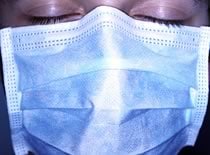They also estimated that between 9,000 and 21,000 hospitalizations occurred during that time. The estimates are in a CDC publication, Emerging Infectious Diseases, and were posted on the journal's Web site this week. To come up with the numbers, the scientists assumed that most people infected with swine flu had only mild illnesses and did not get medical care or get tested.
For every confirmed case, they estimated that probably 80 others occurred. Rates of testing and hospitalization have dropped since the pandemic began, so the same calculation couldn't be done for cases since late July. For that reason, CDC officials are saying simply that "many millions" of Americans have been infected to date, the CDC's Dr. Anne Schuchat said at a press conference Thursday in Atlanta. Schuchat also provided an update on a shortage of the children's version of the drug Tamiflu, a first-line treatment for swine flu. The shortage first emerged last month. Since then, the federal government has released 300,000 pediatric Tamiflu doses to the states from a national medicine stockpile. The shortage occurred because the drug's manufacturer, Switzerland-based Roche Holdings, decided to focus production on adult-strength capsules as it dealt with increasing demand for the medication. The company increased the capsules' production as a way to ensure more medicine was made in the fastest way possible. Though there are scattered shortages of pediatric doses, adult-strength Tamiflu pills are in good supply and pharmacies can turn them into a Tamiflu syrup for children, said Schuchat, who heads the CDC's National Center for Immunization and Respiratory Diseases.
FROM CANADA; H1N1 exposes problems in System
The Manitoba and Ontario governments confirmed they are bracing for fewer doses of the vaccine.
"There is a suggestion, that we have received, that there may be less available over the next two weeks," said Ontario's chief medical officer of health, Arlene King. "I look forward to hearing more from the federal government." Ontario's health minister, Deb Matthews, said the federal government had not told the province officially what the reduced amount "might be" and that she was hoping to learn the final number by today.
The last-minute numbers mean local public health units, which are responsible for administering the vaccine, may have to modify plans over the weekend for how they operate clinics next week.
The federal government said it was informed by Canada's H1N1 vaccine manufacturer, GlaxoSmithKline, that vaccine supply will be lower next week because its facility only has one production line for two types of vaccine. GlaxoSmithKline first produced batches of vaccine with an adjuvant - an additive that boosts the immune system - and by the end of today, 6 million doses will have been shipped to the provinces and territories. It temporarily switched its production line to manufacture 1.8 million doses of vaccine without the adjuvant, the vaccine that is preferred for pregnant women. It has now switched back to making the adjuvanted vaccine but because of the interruption caused by making the unadjuvanted vaccine, there is a reduced number of doses for next week.
.jpg) "It is important to also note that every batch of vaccine is quality-tested before it is shipped to the provinces and territories. This also affects the amount of vaccine delivered each week," said a statement from Health Minister Leona Aglukkaq. "GSK assures us that they will be back up to providing the provinces and territories with millions of doses the following week." The minister said the goal is to have Canadians who want the shot immunized by Christmas and that "we remain on track to meet this goal."
"It is important to also note that every batch of vaccine is quality-tested before it is shipped to the provinces and territories. This also affects the amount of vaccine delivered each week," said a statement from Health Minister Leona Aglukkaq. "GSK assures us that they will be back up to providing the provinces and territories with millions of doses the following week." The minister said the goal is to have Canadians who want the shot immunized by Christmas and that "we remain on track to meet this goal."News of the reduced supply comes as two more Canadian H1N1 deaths were reported: a middle-age woman from Edmonton and a man from Calgary. Meanwhile, people anxious for their shot continued to swamp clinics and parents worried about their sick children flooded hospital emergency rooms across the country.
FLU MYTHS THAT COULD KILL YOU
Myth 2 - This is just mild flu. The death rates are even lower than for normal flu. Swine flu is killing young people rather than the very elderly, and although winter is just starting, more young people have already died of flu than normally die over the entire winter.
Myth 3 - Healthy people are safe. Only sick, weak people get really ill. Most of the kids who have died of swine flu were perfectly healthy beforehand, and many of the adult victims also had no underlying conditions.
Myth 4 - Eating organic food, taking vitamins, wearing a mask, washing hands and drinking plenty of fluids will offer protection. Getting vaccinated is by far the most effective thing you can do to protect yourself and your family from swine flu.
Myth 5 - No worries, now that vaccine are available. Vaccines will save lives, but only if they get through in time. Even in rich countries, it will be months before everyone who wants the vaccine can get it. Poor countries will get little if any vaccine.
Myth 6 -The vaccine isn’t safe. No point taking the risk to prevent mild flu. During past pandemics, a third or more of the entire population has got flu, and the risks of flu killing you or causing nasty problems such as Guillain-Barré syndrome are far greater than those of the vaccines.
Myth 7 - This virus won’t get deadlier. Flu viruses do sometimes get nastier. No one can be sure how 2009 flu will evolve, but it’s certainly not going away.
Myth 8 - Once this pandemic is over, world will be safe for another few decades. Another animal flu virus could jump to humans tomorrow and start another pandemic, which could be far worse than 2009 swine flu.



 The main way that influenza viruses are thought to spread is from person to person in respiratory droplets of coughs and sneezes. This can happen when droplets from a cough or sneeze of an infected person are propelled through the air and deposited on the mouth or nose of people nearby. Influenza viruses may also be spread when a person touches respiratory droplets on another person or an object and then touches their own mouth or nose (or someone else’s mouth or nose) before washing their hands.
The main way that influenza viruses are thought to spread is from person to person in respiratory droplets of coughs and sneezes. This can happen when droplets from a cough or sneeze of an infected person are propelled through the air and deposited on the mouth or nose of people nearby. Influenza viruses may also be spread when a person touches respiratory droplets on another person or an object and then touches their own mouth or nose (or someone else’s mouth or nose) before washing their hands.












